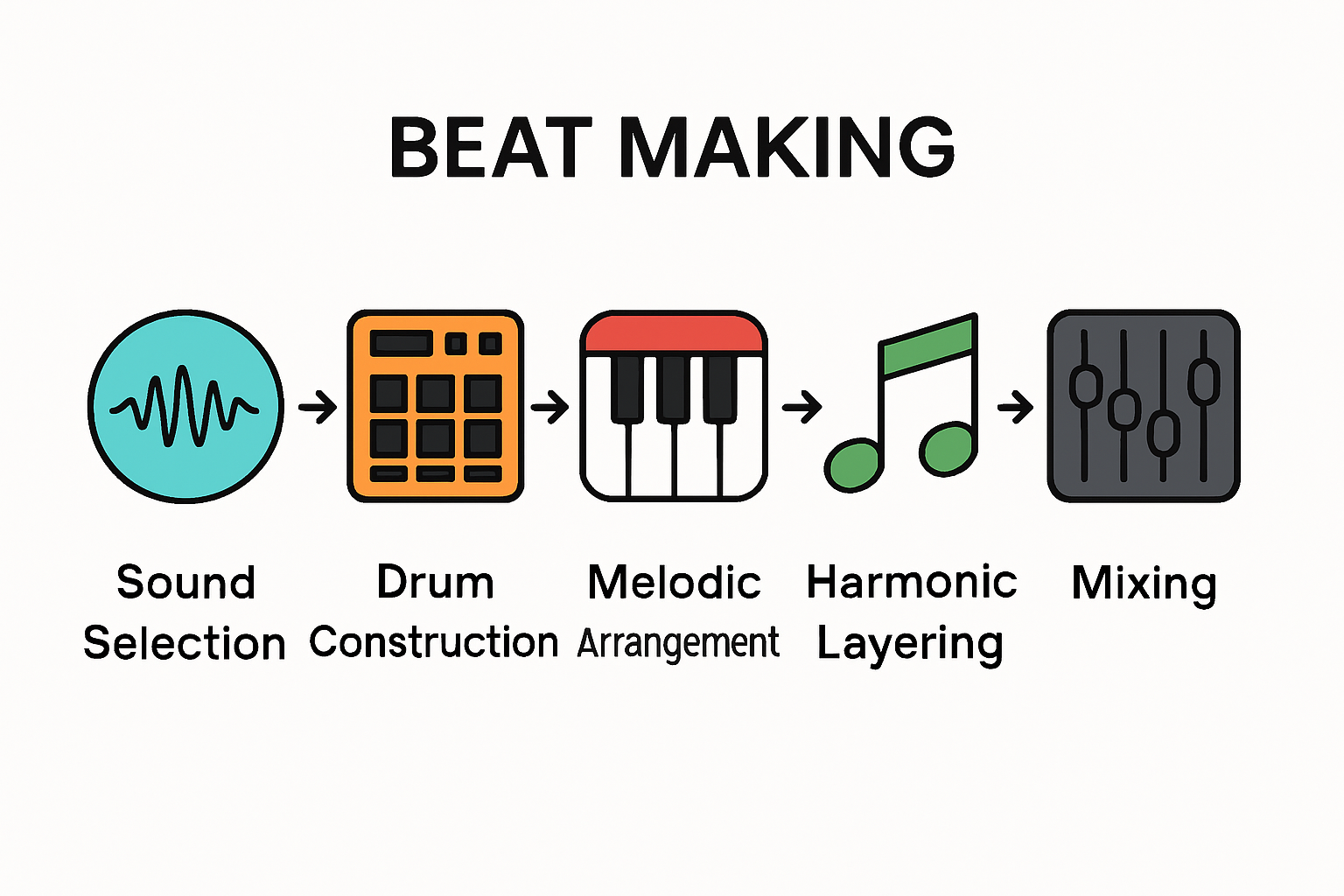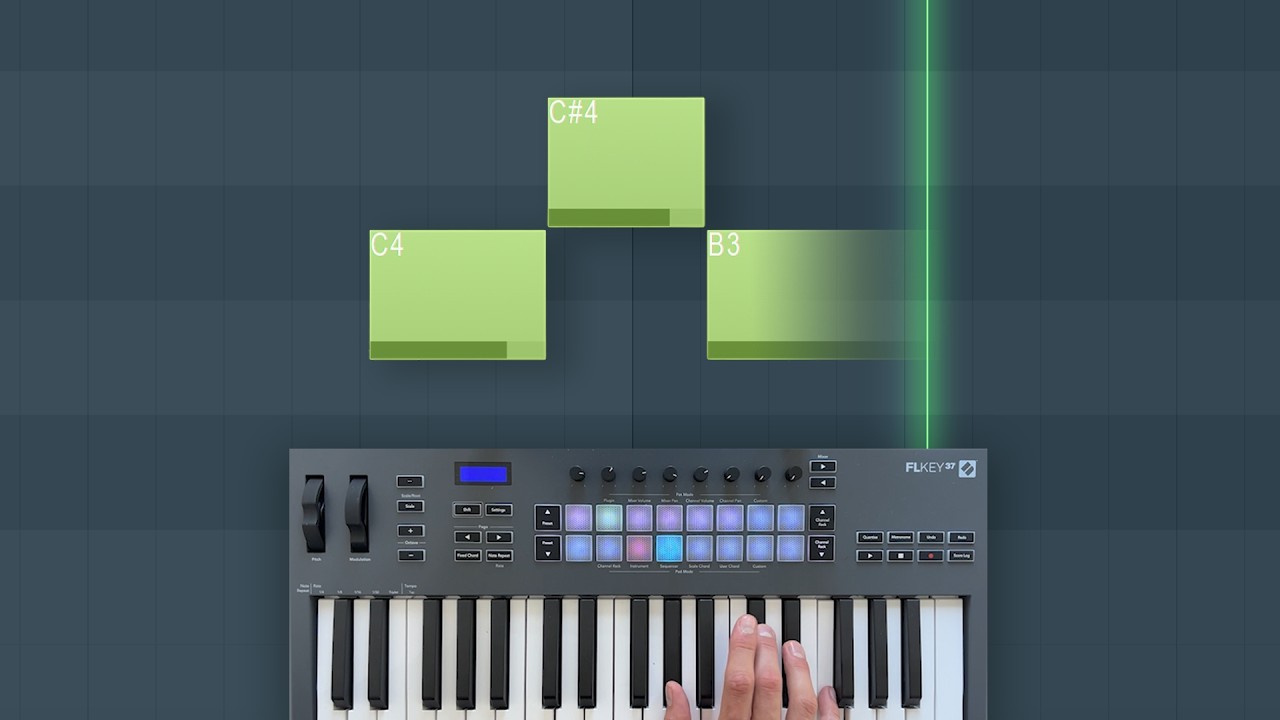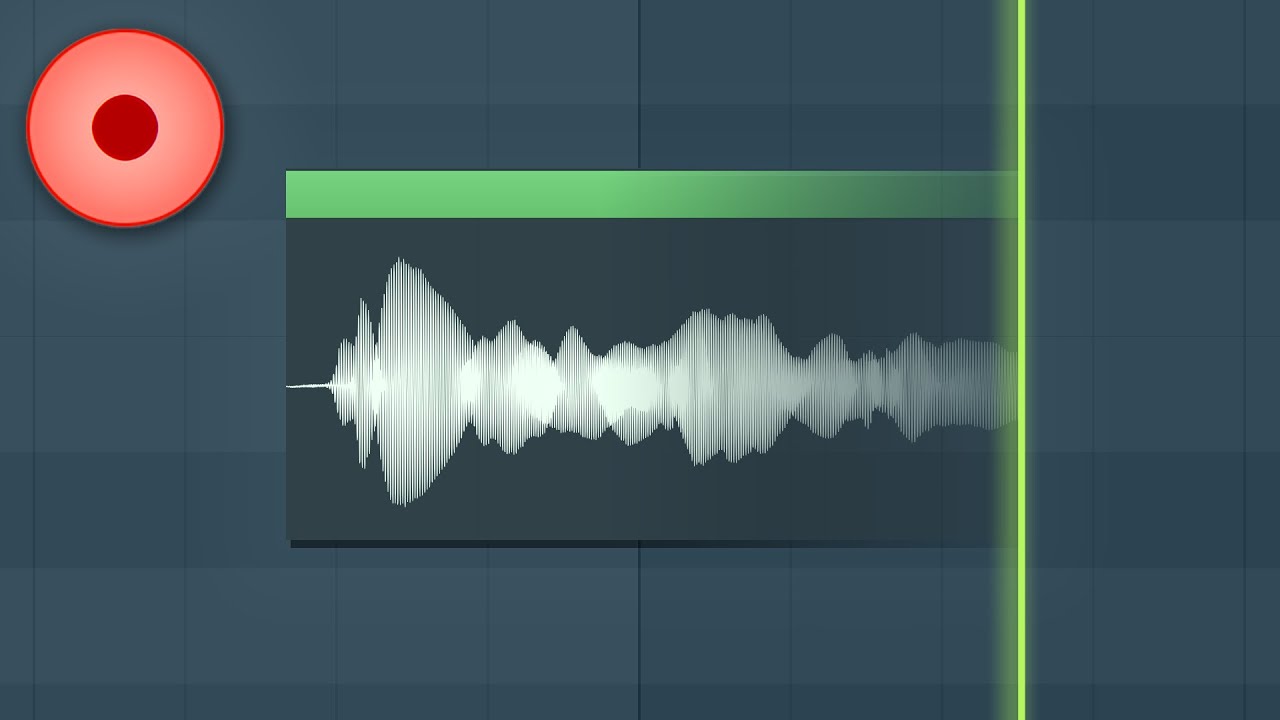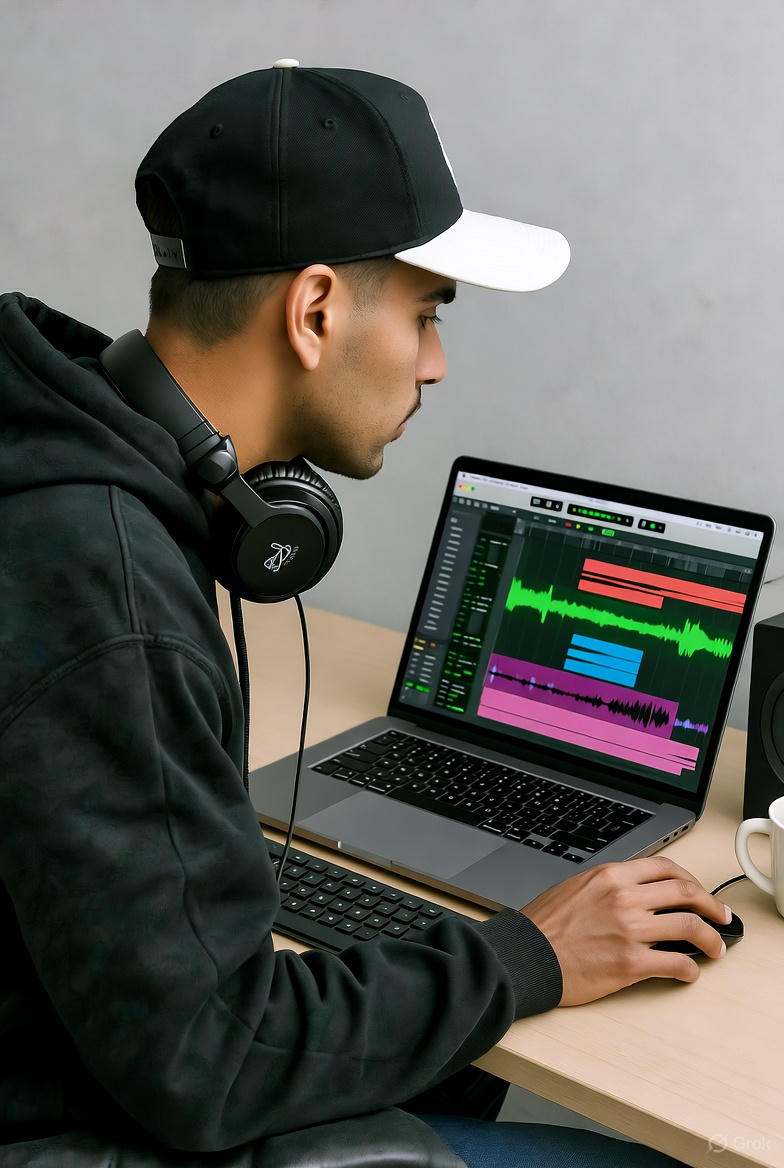!Let Us HELP YOU!
We have a lot of curated content on this blog.
Take this simple 20 second Quiz to Help You
Find The Exact Content You Are Looking For!
Beat making has redefined how modern music is built, turning simple ideas into full tracks that shape entire genres. Yet while technology grabs lots of attention, the real power comes from a structured workflow that can help a producer turn creativity into polished music nearly every time. Most people think beat making is just about playing around with sounds, but a smart workflow is what truly drives results and sets professionals apart.
Table of Contents
-
How Workflow Influences Creativity And Productivity In Music
-
Real-World Applications: Successful Beat Makers And Their Workflows
Quick Summary
| Takeaway | Explanation |
| Establish a structured workflow | A systematic approach enhances consistent creativity and productivity in beat making. |
| Integrate advanced technology | Utilize digital tools and platforms to streamline production and enhance musical complexity. |
| Focus on personal signature | Develop unique techniques and strategies that reflect individual creativity and artistic identity. |
| Prioritize sound selection | Careful sampling and sound choice form the backbone of compelling beats and compositions. |
| Embrace psychological benefits | A structured workflow reduces decision fatigue and enhances innovative musical exploration. |
Defining the Beat Making Workflow: What It Is
A beat making workflow is the systematic process through which music producers transform creative musical ideas into fully realized instrumental tracks. Unlike traditional music composition, beat making represents a modern approach to music creation that combines technical skill, artistic expression, and digital technology.
The Core Components of Beat Making
Beat making is fundamentally about creating rhythmic foundations that serve as musical backbones for various genres. At its essence, the workflow involves several interconnected stages that transform raw musical concepts into polished instrumental tracks. These stages typically include:
-
Sound selection and sampling
-
Drum pattern construction
-
Melodic element arrangement
-
Harmonic layering
-
Audio mixing and refinement
Producers approach beat making as both a technical and creative process. They utilize digital audio workstations (DAWs) to manipulate sounds, craft unique rhythms, and construct musical landscapes that can support vocal performances or stand alone as instrumental pieces.
Understanding Musical Architecture
The beat making workflow is essentially about architectural musical design. Just as an architect plans a building’s structure before construction, music producers meticulously plan their sonic structures. Learn more about mastering your beats to understand how each element contributes to the final sonic blueprint.
According to Coursera’s Music Production Course, successful beat making requires a combination of technical proficiency and creative intuition. Producers must understand rhythm, harmony, and sound design while simultaneously allowing space for spontaneous musical inspiration.
While each producer develops a unique workflow, the fundamental goal remains consistent: transforming abstract musical ideas into compelling, professionally crafted instrumental tracks that resonate with listeners across multiple genres.
To clarify the essential building blocks of a beat making workflow, the table below summarizes the core components and their main focus within the production process.
| Component | Main Focus |
| Sound selection & sampling | Choosing and manipulating source sounds to build the beat |
| groundwork | |
| Drum pattern construction | Creating rhythmic structures to drive the track |
| Melodic arrangement | Organizing melody lines for musical direction |
| Harmonic layering | Adding chords and harmonies for depth and richness |
| Audio mixing & refinement | Balancing elements and fine-tuning the final sound |
The Importance of an Effective Workflow in Beat Production
An effective workflow represents the strategic backbone of successful music production, transforming raw creative potential into polished, professional musical compositions. For beat makers, developing a structured approach is not just about technical efficiency but about creating a consistent framework that supports artistic creativity and professional growth.
Enhancing Creative Consistency
Workflow management in beat production goes beyond mere organizational tactics. It establishes a repeatable process that allows producers to maintain high quality while reducing mental friction during the creative process. Consistent workflows enable producers to focus more on artistic expression and less on technical obstacles.
Key benefits of a well-structured beat making workflow include:
-
Reducing decision fatigue during production
-
Maintaining a steady creative output
-
Minimizing time spent on repetitive technical tasks
-
Creating a predictable creative environment
-
Establishing a personal production signature
Technological Integration and Efficiency
Modern beat production workflows leverage advanced technological tools to streamline the creative process. Check out our guide on beat making techniques to understand how strategic workflow design can significantly enhance musical productivity.
Research from AI music production studies indicates that systematic workflows integrated with intelligent technologies can dramatically improve a producer’s efficiency. By establishing clear processes, producers can create more sophisticated beats with less cognitive overhead, allowing for more nuanced and complex musical compositions.
Ultimately, an effective workflow is about creating a personalized system that amplifies individual creative strengths while mitigating potential production bottlenecks.
WEBSITE RESOURCES FOR MUSICIANS
The following table provides a visual comparison of the psychological and technological benefits of implementing a structured workflow in beat making, highlighting how each aspect contributes to creativity and productivity.
| Aspect | Key Benefit | Example Impact on Production |
| Psychological | Reduces decision fatigue | Enables focus on creative choices |
| Psychological | Minimizes performance anxiety | Fosters experimentation and innovation |
| Technological | Streamlines repetitive tasks | Speeds up production process |
| Technological | Integrates advanced tools | Allows complex compositions with ease |
| Both | Supports consistent output | Leads to reliable, high-quality tracks |

Components of a Beat Making Workflow: Tools and Techniques
A comprehensive beat making workflow integrates specialized digital tools with creative techniques, transforming musical ideas into professional-grade compositions. These components serve as the essential building blocks that enable producers to translate their artistic vision into tangible sonic experiences.

Digital Audio Workstation (DAW) Foundations
The digital audio workstation serves as the central hub of modern beat production. DAWs are sophisticated software platforms that consolidate recording, editing, mixing, and sound design capabilities into a single integrated environment. Producers utilize these powerful tools to construct complex musical arrangements with unprecedented precision and flexibility.
Key technological components of a robust beat making workflow include:
-
Professional grade digital audio workstations
-
MIDI controllers and keyboard interfaces
-
High quality audio interfaces
-
Software synthesizers and virtual instruments
-
Sample libraries and sound packs
Advanced Production Techniques
Successful beat makers understand that technical tools must be complemented by sophisticated production techniques. Explore advanced beat making strategies to elevate your musical production skills and understand the nuanced approaches professionals employ.
According to AI music production research, emerging technologies are revolutionizing beat making workflows by introducing intelligent composition assistants and automated mixing tools. These innovations enable producers to focus more on creative expression while technological systems handle complex technical processes.
The intersection of creative intuition and technological innovation defines modern beat production. Producers must develop a holistic approach that balances technical proficiency with artistic vision, continuously adapting their workflow to leverage emerging tools and techniques.
How Workflow Influences Creativity and Productivity in Music
Workflow represents more than a technical process in music production. It serves as a critical mechanism that directly shapes creative output, psychological engagement, and overall productivity for beat makers and music producers. The relationship between structured workflow and artistic expression is complex and multidimensional.
Psychological Foundations of Creative Workflow
Structured workflows function as cognitive scaffolding that supports creative thinking, enabling producers to navigate complex musical ideas with greater ease and confidence. By establishing predictable processes, musicians can reduce mental friction and allocate more cognitive resources toward innovative musical exploration.
Key psychological benefits of an optimized workflow include:
-
Reducing decision fatigue during creative processes
-
Creating a reliable mental framework for musical experimentation
-
Minimizing creative blockages and performance anxiety
-
Establishing consistent pathways for musical ideation
-
Facilitating faster translation of abstract musical concepts
Technological Mediation of Creative Processes
Learn more about advanced beat making strategies to understand how workflow design can transform musical creativity. The integration of technological tools plays a significant role in shaping creative productivity.
According to computational creativity research, structured workflows with computational tools can substantially enhance creative potential by providing systematic approaches to musical composition. These tools create environments where technological infrastructure supports rather than constrains artistic expression.
Ultimately, an effective workflow transcends mere technical efficiency. It becomes a personalized creative ecosystem that adapts to individual artistic sensibilities, transforming the complex process of musical production into a more intuitive, responsive, and fulfilling experience.
Real-World Applications: Successful Beat Makers and Their Workflows
Successful beat makers demonstrate that workflow is not a rigid system but a dynamic, personalized approach to musical creation. Their unique methodologies reveal how individual creativity can be systematically channeled through strategic production techniques and technological tools.
Signature Production Techniques
Each successful beat maker develops a distinctive workflow that becomes their sonic signature. These personalized systems blend technical precision with artistic intuition, transforming raw musical ideas into memorable compositions. The workflow becomes an extension of the producer’s creative identity, reflecting their musical philosophy and technical expertise.
Characteristics of influential beat makers’ workflows include:
-
Innovative sample selection strategies
-
Unique drum programming techniques
-
Specialized sound manipulation methods
-
Custom signal processing approaches
-
Unconventional arrangement structures
Technology and Personal Style
Explore advanced beat making strategies to understand how professional producers leverage technology within their creative workflows. The integration of specific tools and techniques becomes a critical differentiator in musical production.
Research on AI music production technologies demonstrates how successful producers adapt emerging tools to amplify their creative processes. By selectively integrating technological innovations, beat makers can expand their musical capabilities while maintaining their unique artistic voice.
Ultimately, a truly effective workflow transcends technical templates. It represents a deeply personal musical ecosystem that evolves continuously, reflecting the producer’s growing artistic vision and technical mastery.
Transform Your Beat Making Workflow Into Real Results
Are you feeling stuck turning creative ideas into fully finished tracks? The article on understanding the beat making workflow highlights how technical barriers, scattered tools, and uncertainty about the right next step can hold you back. Many music producers struggle to move past drum pattern construction, sound selection, or mixing because their approach is not streamlined. This often leads to frustration, wasted time, and inconsistent results.
Break through these roadblocks today by exploring our hands-on resources across every genre and production stage. At howtomakebeatsblog.com, you will discover in-depth DAW tutorials for FL Studio, Logic, Ableton, and Pro Tools, plus honest reviews of MIDI keyboards, drum kits, sample packs, and more. You will also find step-by-step guides and advanced beat making strategies that simplify your path from idea to professional instrumental. Take control of your creative workflow now and join a community of producers building powerful, repeatable processes that deliver better beats faster.
Visit howtomakebeatsblog.com now to upgrade your workflow and turn your creative visions into finished tracks.
Frequently Asked Questions
What is a beat making workflow?
A beat making workflow is a systematic process that music producers use to transform creative musical ideas into fully realized instrumental tracks, combining technical skills with artistic expression and digital technology.
What are the key components of a beat making workflow?
The key components typically include sound selection and sampling, drum pattern construction, melodic arrangement, harmonic layering, and audio mixing and refinement.
How does workflow affect creativity in music production?
An effective workflow serves as cognitive scaffolding that supports creative thinking, reducing mental friction and allowing producers to focus more on artistic expression rather than technical challenges.
What technological tools are essential for beat making?
Essential tools for beat making include digital audio workstations (DAWs), MIDI controllers, audio interfaces, software synthesizers, and sample libraries, which all facilitate the production process.



